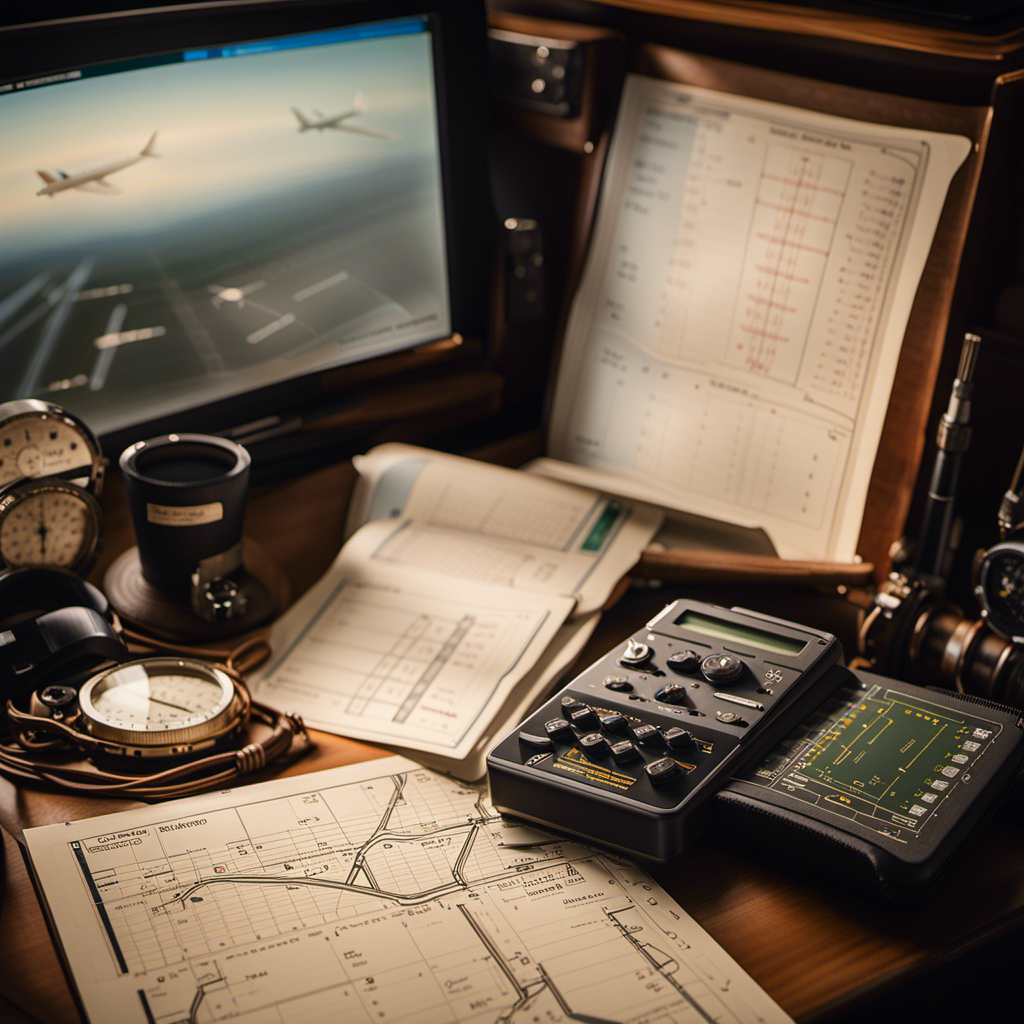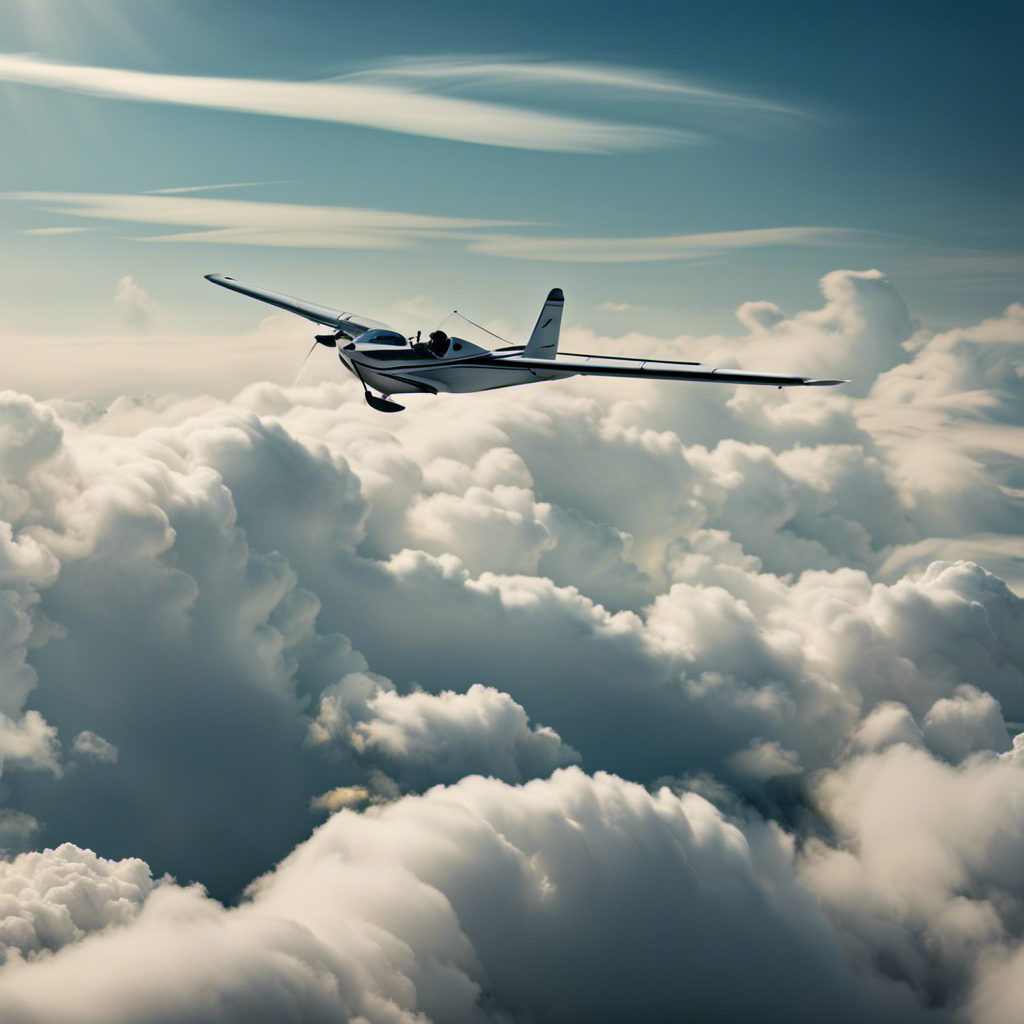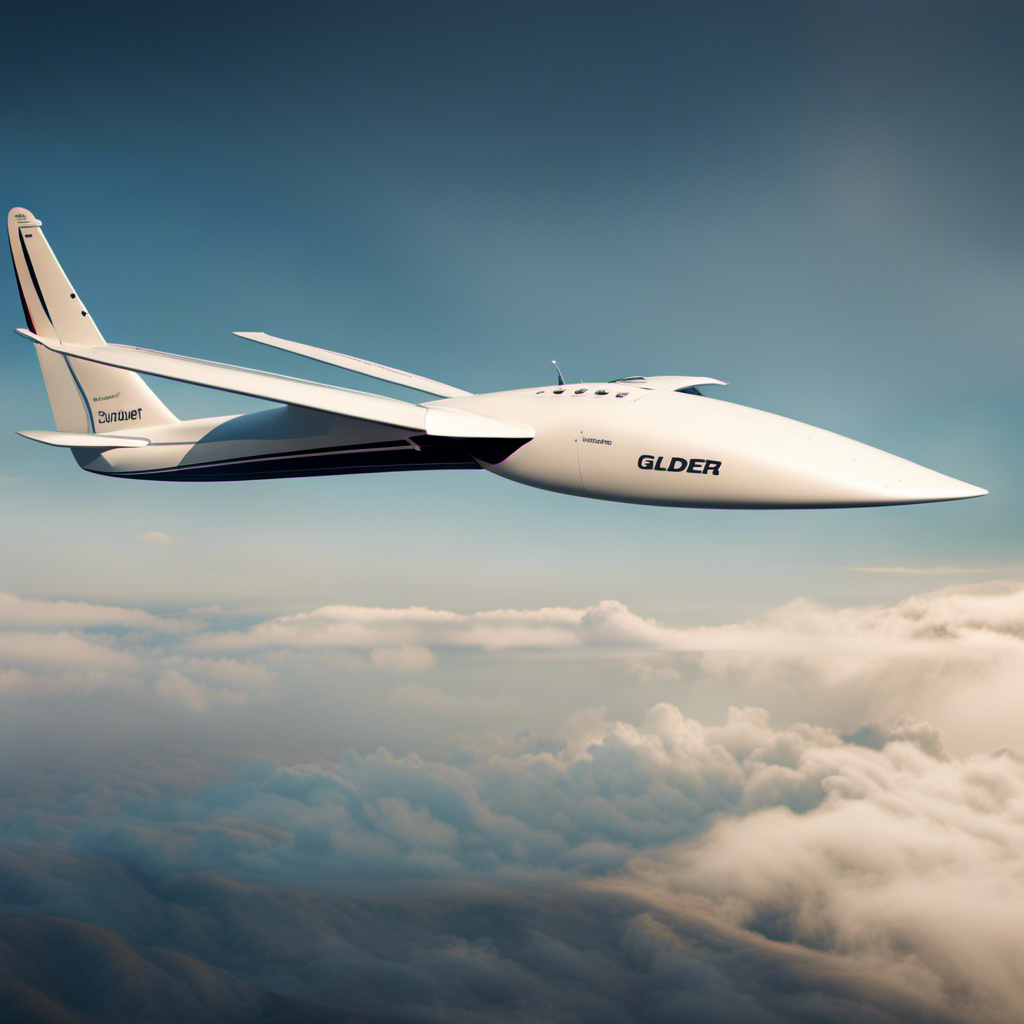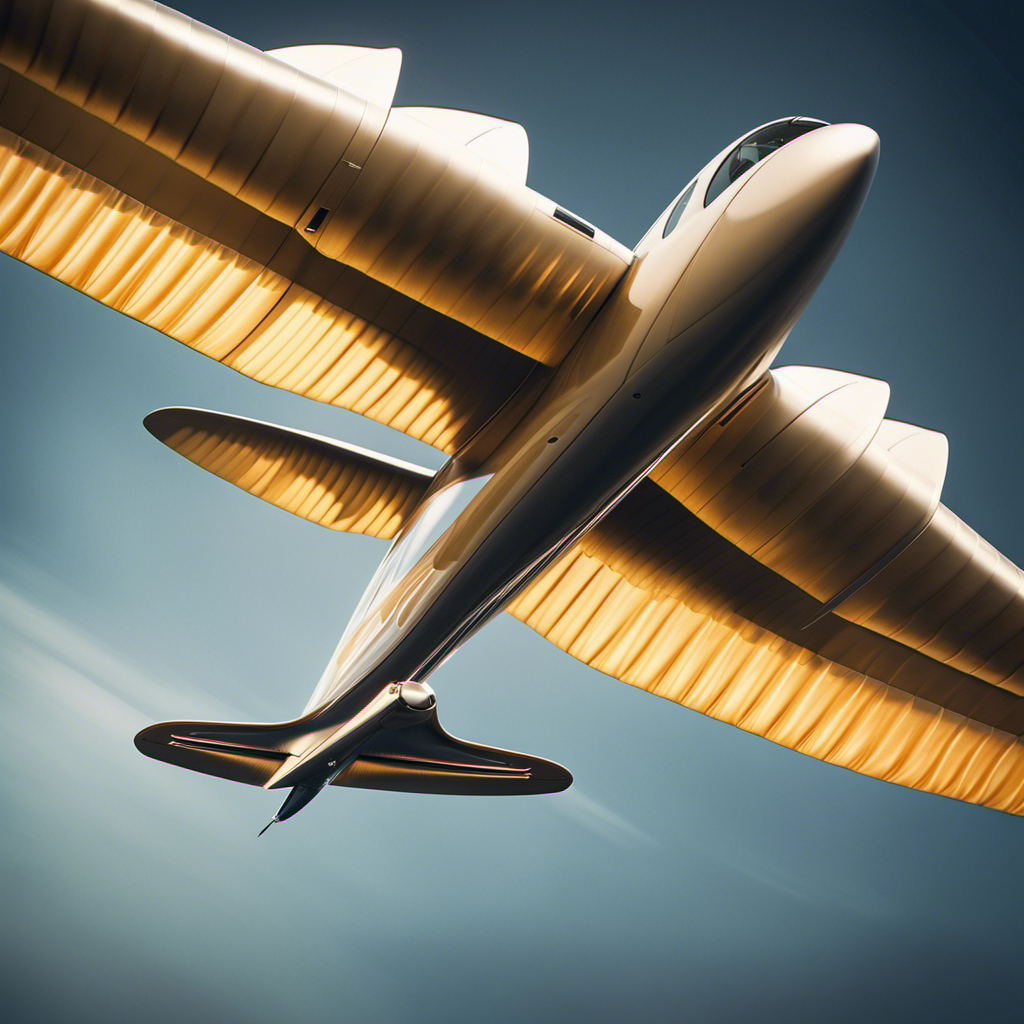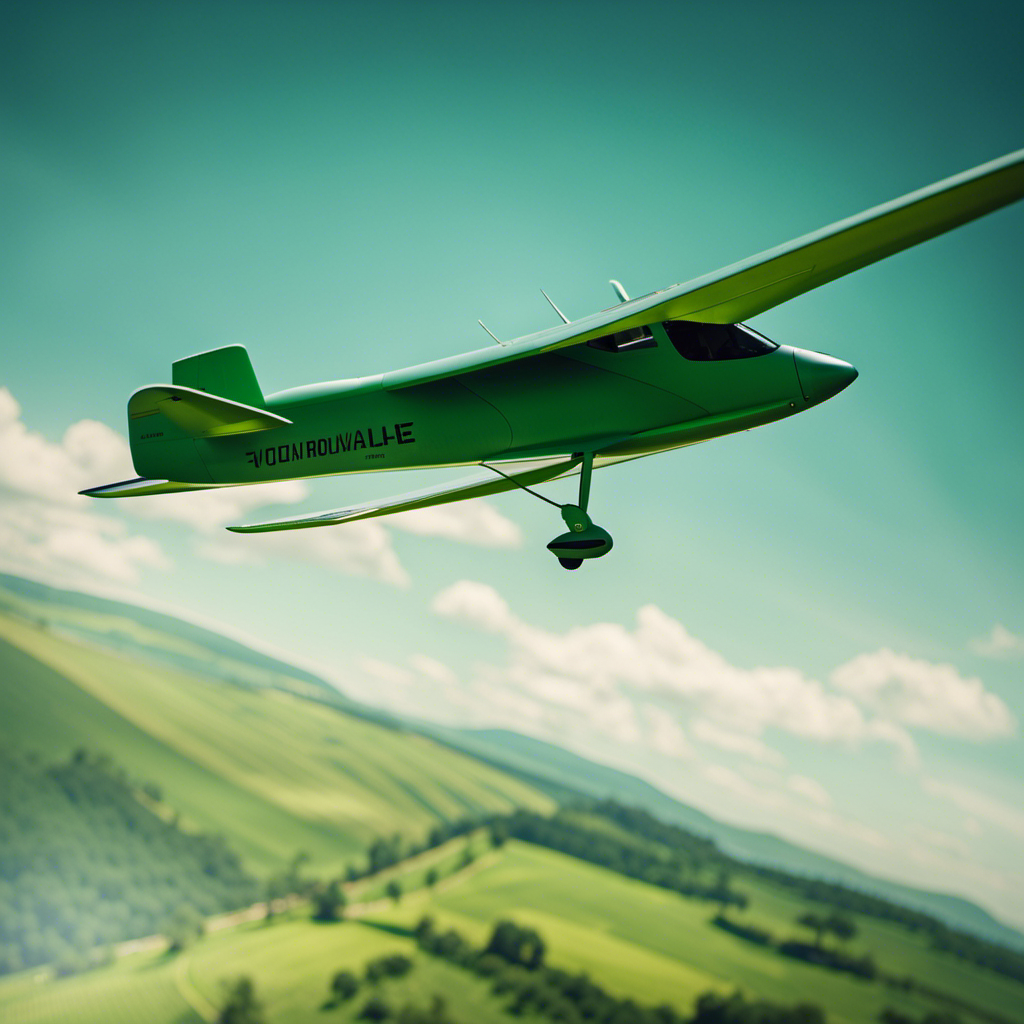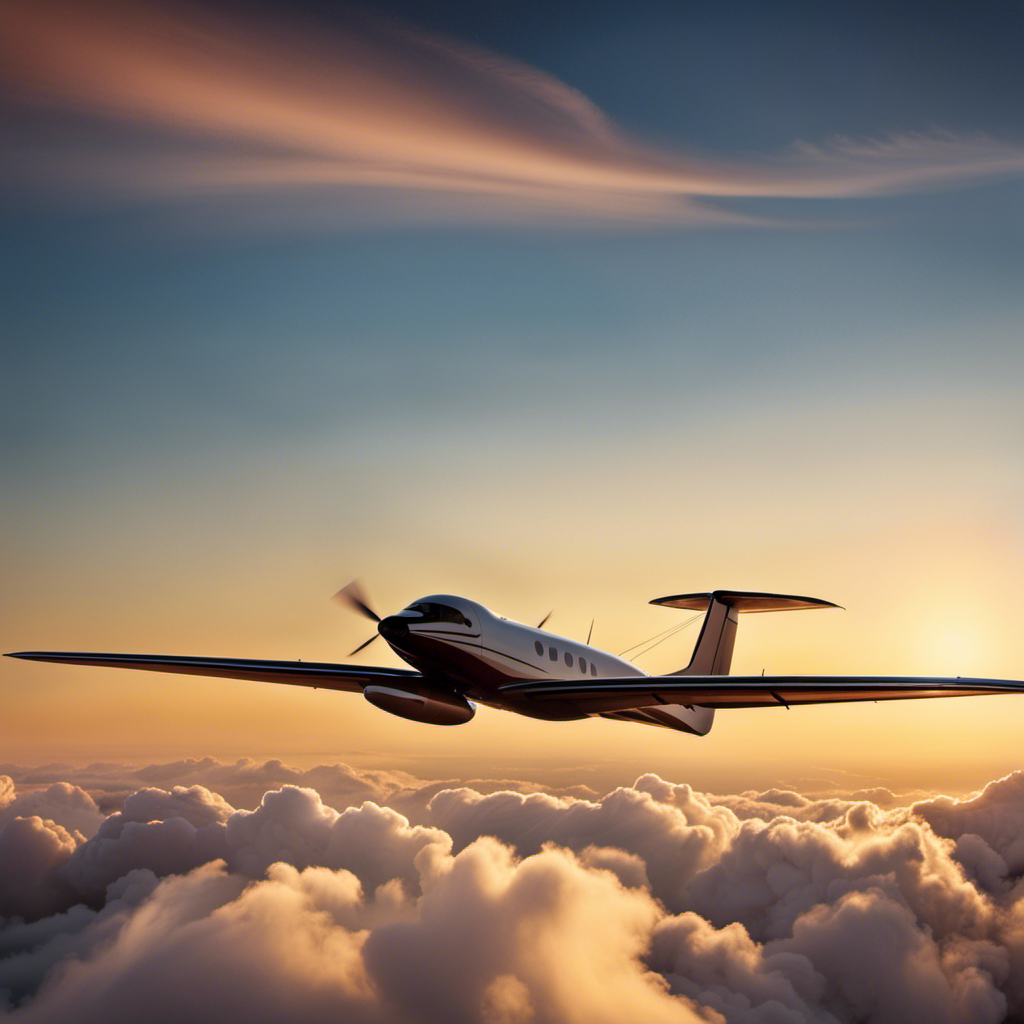As a glider pilot, I recognize the importance of studying for the theoretical exam in order to achieve my goals. This knowledge will serve as the foundation for my skills and knowledge to grow.
To soar through the skies with confidence, I must understand the principles of flight, aviation regulations, weather patterns, navigation techniques, glider performance, radio communication, human factors, glider maintenance and inspections, as well as cross-country flying.
Let’s embark on this journey together, unraveling the intricacies of glider pilot knowledge.
Key Takeaways
- Understanding aerodynamic forces and flight controls is essential for safe and efficient glider flying.
- Knowledge of weather patterns and wind patterns is crucial for making informed decisions and optimizing flight performance.
- Navigation skills, including the use of navigation tools and instruments, are necessary for planning flight routes and navigating during flight.
- Effective radio communication, maintenance and inspections, and cross-country flying techniques are important aspects of glider pilot training and safety.
Principles of Flight
The principles of flight are essential to understand for the glider pilot written exam. As a glider pilot, it is crucial to have a technical understanding of aerodynamic forces and flight controls.
Aerodynamic forces are the forces acting on an aircraft during flight. The four main forces are lift, weight, thrust, and drag. Lift is generated by the wings and opposes the force of gravity, allowing the glider to stay airborne. Weight is the force exerted on the glider due to gravity. Thrust is the force that propels the glider forward. Drag is the resistance encountered by the glider as it moves through the air.
Flight controls are the means by which pilots manipulate the aerodynamic forces acting on the glider. The primary flight controls include the ailerons, elevator, and rudder. Ailerons are located on the wings and control the roll of the glider. Elevator is located on the tail and controls the pitch. Rudder is also located on the tail and controls the yaw. By understanding how these flight controls affect the aerodynamic forces, a glider pilot can maintain control and stability during flight.
Understanding the principles of flight and how aerodynamic forces and flight controls work together is crucial for safe and successful glider flying. Now that we have covered the principles of flight, let’s delve into the next important topic of aviation regulations.
Aviation Regulations
Aviation regulations can be a complex topic to understand for aspiring glider pilots. However, it is crucial to have a solid grasp of these regulations in order to ensure aviation safety and effectively navigate the airspace. Here are three key aspects of aviation regulations that glider pilots need to study:
-
Airspace classification: Understanding the different types of airspace is essential for glider pilots. Class A airspace, for example, is reserved for high-altitude commercial traffic and is usually not relevant to glider operations. On the other hand, Class G airspace is uncontrolled and often used by glider pilots. Knowing the rules and restrictions associated with each class of airspace is crucial for safe flying.
-
Restricted areas: Restricted areas are designated areas where certain activities, such as military operations, take place. It is important for glider pilots to be aware of these areas and avoid flying into them. Familiarizing oneself with the location and boundaries of restricted areas is vital for aviation safety.
-
Special use airspace: Special use airspace includes areas such as military training routes, temporary flight restrictions, and national security areas. These areas may have additional rules and restrictions that glider pilots must adhere to. Being aware of any special use airspace in the vicinity of a planned flight route is essential to avoid any potential conflicts or hazards.
Understanding aviation regulations related to airspace classification, restricted areas, and special use airspace is crucial for aspiring glider pilots. By studying and applying these regulations, glider pilots can ensure aviation safety and navigate the skies with confidence.
As we transition into the subsequent section about weather patterns, it is important for glider pilots to also study meteorology in order to make informed decisions about when and where to fly.
Weather Patterns
Understanding weather systems, cloud formations, and wind patterns is crucial for glider pilots.
Weather systems dictate the conditions in which we fly and can greatly affect our safety and performance.
Cloud formations provide important visual cues that can indicate areas of rising or sinking air.
Wind patterns determine the direction and strength of air currents that we rely on for gliding.
Understanding weather systems
Learning about weather systems is crucial for glider pilots. As a pilot myself, I understand the importance of understanding atmospheric phenomena and analyzing weather data. It allows us to make informed decisions and ensures our safety in the air.
Here are four key aspects of weather systems that every glider pilot should be familiar with:
-
Wind patterns: Knowing how wind behaves in different weather conditions helps us navigate effectively and make strategic decisions during flight.
-
Air pressure: Understanding changes in air pressure helps us anticipate weather changes and identify areas of potential turbulence.
-
Temperature gradients: Recognizing temperature variations can help us identify areas of unstable air and avoid hazardous conditions.
-
Moisture levels: Monitoring moisture levels in the atmosphere helps us predict the formation of clouds and the likelihood of precipitation.
Cloud formations and their significance
As a glider pilot, you’ll notice that different cloud formations can provide valuable information about the current weather conditions.
Clouds are not just beautiful formations in the sky; they can give us insight into the invisible forces at work.
For example, cumulus clouds with towering vertical growth indicate the presence of updrafts, which are columns of rising air. These updrafts generate thermals, which are pockets of warm air that can provide lift for the glider.
On the other hand, if you see dark, rain-filled clouds, known as cumulonimbus clouds, be cautious as they can be associated with strong downdrafts and turbulent conditions.
Understanding cloud formations and their significance is crucial for a glider pilot to make informed decisions during a flight.
Now, let’s explore wind patterns and their effects on gliding.
Wind patterns and their effects on gliding
As I delve deeper into the study of gliding, I can’t help but be fascinated by the intricate relationship between wind patterns and the art of soaring. Understanding how wind behaves and its effects on gliding is crucial for a successful flight. Here are four key aspects to consider:
-
Wind direction: The direction from which the wind is blowing greatly affects the flight path and maneuverability of the glider.
-
Wind speed: Higher wind speeds can provide greater lift and allow for longer flights.
-
Effect of thermals: Thermals, pockets of warm air rising from the ground, can be utilized by glider pilots to gain altitude and extend their flight time.
-
Ridge soaring: This technique involves flying along the ridge of a hill or mountain, utilizing the upward draft of wind that hits the slope.
Understanding wind patterns and their effects on gliding is essential for safe and efficient flying. Now, let’s explore the next section on navigation techniques.
Navigation Techniques
You’ll need to familiarize yourself with various navigation techniques for your glider pilot written exam. Navigation is a crucial skill for any pilot, as it ensures safe and efficient flight from one point to another. Here are some key techniques to study:
| Technique | Description |
|---|---|
| Dead Reckoning | Calculating position based on known groundspeed, heading, and time. |
| Pilotage | Navigating by visual reference to landmarks on the ground. |
| Radio Navigation | Using radio signals to determine position and track. |
| GPS Navigation | Utilizing Global Positioning System to navigate accurately. |
These techniques are not only important for normal flight, but also for emergency procedures. In the event of an emergency, knowing how to navigate effectively can be crucial for finding a suitable landing spot or reaching help. Understanding these techniques will not only help you pass your written exam, but also ensure your safety and success as a glider pilot.
Transitioning into the subsequent section about ‘glider performance’, it’s important to note that navigation techniques are closely tied to understanding the capabilities and limitations of your glider. By combining your knowledge of navigation with an understanding of glider performance, you’ll be able to make informed decisions during flight and maximize your efficiency.
Glider Performance
After successfully mastering navigation techniques, it is important to delve into the fascinating world of glider performance. Understanding the principles of glider aerodynamics and thermals analysis is crucial for optimizing flight efficiency and achieving longer distances. Let’s explore some key aspects of glider performance:
-
Lift-to-Drag Ratio: This ratio determines how efficiently a glider converts lift into forward motion. Higher ratios result in better gliding performance.
-
Wing Loading: The ratio of the glider’s weight to its wing area affects its performance. Lighter wing loading allows for better maneuverability and climbing ability.
-
Glide Polar: This graph represents the glider’s performance at different airspeeds. It shows the relationship between sink rate and airspeed, helping pilots find the optimal speed for maximum efficiency.
-
Energy Management: Mastering energy management techniques, such as speed-to-fly and using thermals effectively, is essential for maintaining altitude and extending flight time.
-
Center of Gravity: The correct placement of the center of gravity ensures stability and optimal performance during flight.
By studying glider performance, pilots can make informed decisions during flights, maximizing their chances of success.
Now, let’s transition to the next section where we will explore the crucial topic of emergency procedures.
Emergency Procedures
When it comes to dealing with in-flight emergencies, it is crucial for pilots to remain calm and focused.
In emergency situations, landing becomes a top priority, and pilots must be prepared to execute emergency landing procedures.
Understanding and utilizing emergency equipment and procedures is essential for ensuring the safety of everyone on board.
Dealing with in-flight emergencies
If an in-flight emergency occurs, don’t panic and remember to follow the emergency procedures. Here are three important steps to deal with in-flight emergencies:
-
Dealing with bird strikes: If a bird strikes the aircraft, maintain control and assess the damage. If necessary, declare an emergency and communicate with air traffic control. Follow the appropriate checklist for bird strike recovery, which may involve inspecting the aircraft for damage and determining if it is safe to continue or if a diversion is required.
-
Handling engine failures: In the event of an engine failure, immediately establish the best glide speed and find a suitable landing area. Follow the engine failure checklist to try restarting the engine or secure it if necessary. Communicate with air traffic control and prepare for an emergency landing.
When faced with these emergencies, it is crucial to remain focused and follow the proper procedures to ensure the safety of all onboard.
Now, let’s discuss landing in emergency situations.
Landing in emergency situations
To safely land in emergency situations, you should remain calm and follow the emergency landing procedures. These procedures are designed to ensure your safety and minimize the risks associated with emergency landings. By following these steps, you can increase your chances of a successful outcome.
Below is a table outlining the emergency landing procedures:
| Step | Procedure | Description |
|---|---|---|
| 1 | Assess the situation | Evaluate the nature and severity of the emergency |
| 2 | Communicate with ATC | Notify air traffic control of your situation |
| 3 | Execute emergency checklist | Follow the appropriate checklist for the situation |
| 4 | Choose a suitable landing spot | Identify a safe landing area |
| 5 | Land the aircraft | Execute a controlled landing utilizing best practices |
Emergency equipment and procedures
Make sure you’re familiar with the emergency equipment and procedures so you can respond effectively in challenging situations. In the event of an emergency landing, it’s crucial to understand the emergency equipment and how to use it. Here are three important aspects to consider:
-
Regular maintenance: Conduct regular maintenance checks on all emergency equipment to ensure they’re in proper working condition. This includes inspecting the emergency locator transmitter (ELT), life jackets, fire extinguishers, and first aid kits.
-
Familiarization: Take the time to familiarize yourself with the location and operation of each piece of emergency equipment. This will help you respond quickly and efficiently during an emergency situation.
-
Training: Attend training sessions and participate in drills that simulate emergency scenarios. This will allow you to practice using the emergency equipment and familiarize yourself with the procedures.
Understanding emergency equipment and procedures is vital for the safety of yourself and your passengers.
Transitioning into the next section, effective radio communication plays a crucial role in ensuring a successful outcome during emergency situations.
Radio Communication
Remember to familiarize yourself with proper radio communication procedures for your glider pilot written exam. Radio communication is an essential skill for all glider pilots, as it allows for effective communication with air traffic control and other aircraft. When studying for your exam, it is important to understand the importance of clear and concise communication in ensuring safe and efficient flight operations.
One key aspect to consider when studying radio communication is weather forecasting. Weather plays a crucial role in aviation, and being able to interpret and communicate weather information is vital for a glider pilot. Familiarize yourself with the various weather reports and forecasts available, and understand how to relay this information accurately over the radio.
Another important area to study is airspace regulations. As a glider pilot, you must be aware of the different types of airspace and their associated restrictions. Understanding the rules and procedures for entering and operating within controlled airspace is essential for maintaining safety and compliance.
Transitioning into the next section about ‘human factors,’ it is important to remember that effective communication is not only about technical procedures, but also about understanding the human element involved. Being able to communicate clearly and calmly, even in high-stress situations, is crucial for maintaining safe and efficient flight operations.
Human Factors
After learning about the intricacies of radio communication in glider piloting, I now move on to the critical topic of human factors. As a glider pilot, it is crucial to understand the impact of human error and how to mitigate it through effective crew resource management.
Human factors encompass a wide range of psychological, physiological, and social factors that can influence pilot performance and decision-making. By studying human factors, I can gain insights into how stress, fatigue, and other cognitive factors can affect my ability to safely operate a glider.
Crew resource management (CRM) plays a significant role in minimizing human error in aviation. It involves utilizing all available resources, including effective communication, coordination, and teamwork, to enhance safety and decision-making. By embracing CRM principles, I can effectively manage workload, prioritize tasks, and collaborate with other crew members to ensure a safe and efficient flight.
Understanding human factors and implementing CRM techniques will greatly contribute to my development as a competent and safe glider pilot.
Now, let’s delve into the importance of glider maintenance and inspections to ensure the airworthiness of the aircraft.
Glider Maintenance and Inspections
To ensure the airworthiness of your glider, you should regularly perform maintenance and inspections. By following proper glider repair techniques and conducting a thorough pre-flight checklist, you can ensure the safety and performance of your aircraft.
Here are some important maintenance and inspection tasks to include in your routine:
- Check the glider’s structure for any signs of damage or wear, such as cracks or loose fittings.
- Inspect the control surfaces, including the ailerons, elevators, and rudder, to ensure they move freely and are properly balanced.
- Examine the glider’s landing gear, including the wheels and brakes, to ensure they are in good condition and functioning correctly.
- Test the glider’s instruments and avionics to ensure they are calibrated and working properly.
Regularly performing these maintenance tasks will help identify any potential issues before they become major problems. Additionally, conducting a pre-flight checklist will ensure that all systems are operating correctly and that the glider is safe to fly.
Now that we have covered the importance of glider maintenance and inspections, let’s move on to the next section about cross-country flying.
Cross-Country Flying
When it comes to cross-country flying, there are three key points to consider: flight planning, route selection and navigation, and managing energy to stay aloft.
Flight planning involves determining the optimal course, considering factors such as wind direction and speed, terrain, and airspace restrictions.
Route selection and navigation require analyzing charts, using navigation aids, and making adjustments based on real-time conditions.
Flight planning
One of the most important aspects of flight planning is ensuring you have accurate weather information. As a pilot, I understand the significance of flight preparation and the role it plays in ensuring a safe and efficient journey.
Fuel management is a crucial component of flight planning, as it directly impacts the aircraft’s performance and endurance. It involves calculating the amount of fuel required for the flight, considering factors such as distance, weight, and weather conditions. By accurately managing fuel consumption, I can optimize the aircraft’s efficiency and avoid any potential fuel shortages during the flight.
Once the flight preparation, including fuel management, is complete, the next step is route selection and navigation. This involves carefully choosing the most suitable route, taking into account factors such as airspace restrictions, weather conditions, and terrain, to ensure a smooth and successful flight.
Route selection and navigation
Choosing the most suitable route for a flight involves carefully considering factors such as airspace restrictions, weather conditions, and terrain. When it comes to route planning, map reading plays a crucial role in ensuring a safe and efficient journey.
Here are some key points to help you navigate through this process:
- Familiarize yourself with the airspace restrictions along your intended route, as certain areas may have limitations or require special permissions.
- Stay updated on current weather conditions, including wind direction and speed, to optimize your flight path and avoid turbulence.
- Take into account the terrain features along your route, such as mountains or valleys, which may affect your altitude and navigation decisions.
By mastering these aspects of route planning and map reading, you can effectively navigate through the skies and make informed decisions to ensure a successful flight.
Now, let’s delve into the next section on managing energy and staying aloft.
Managing energy and staying aloft
Managing energy and staying aloft in flight requires careful monitoring of airspeed, altitude, and wind conditions. As a glider pilot, I employ various maneuvering techniques and soaring strategies to maximize my flight time and distance. One important technique is thermaling, where I circle in rising columns of warm air called thermals. By accurately reading the wind and adjusting my bank angle and turn radius, I can climb higher and gain potential energy. Another technique is ridge soaring, where I fly along the ridge of a hill or mountain, utilizing the upward wind created by the terrain. This allows me to maintain altitude and cover long distances without the need for engine power. By employing these strategies and constantly adjusting my flight path based on the prevailing conditions, I can effectively manage my energy and stay aloft for longer periods of time.
| Technique | Description |
|---|---|
| Thermaling | Circling in rising columns of warm air to gain altitude and potential energy. |
| Ridge Soaring | Flying along the ridge of a hill or mountain, utilizing the upward wind created by the terrain. |
Frequently Asked Questions
Can you explain the process of obtaining a glider pilot license?
To obtain a glider pilot license, one must complete ground and flight training, pass a written exam, and demonstrate proficiency in flying skills. Common mistakes made by beginner glider pilots include improper use of controls and failure to properly assess weather conditions.
What are some common mistakes that beginner glider pilots make?
Common mistakes that beginner glider pilots make include improper weight and balance calculations, failure to maintain proper speed control, and inadequate pre-flight planning. Here are some tips for beginners to avoid these errors.
Are there any specific physical requirements or limitations for becoming a glider pilot?
To become a glider pilot, certain physical requirements must be met. These include good eyesight, hearing, and overall health. However, there are no specific health limitations as long as the pilot meets the physical requirements.
How do glider pilots communicate with air traffic control during flights?
Glider pilots communicate with air traffic control using radio communications. Clear, concise, and precise instructions are exchanged to ensure safe flight operations. Effective communication skills are crucial for proper navigation and coordination in the airspace.
What are some tips for staying safe during cross-country glider flights?
To ensure safety during cross-country glider flights, it is crucial to adhere to a few tips. These include careful weather analysis, proper pre-flight planning, maintaining situational awareness, and conducting thorough risk assessments throughout the journey.
Conclusion
In conclusion, studying for the glider pilot written exam requires a deep understanding of various subjects. Mastery of principles of flight, aviation regulations, weather patterns, navigation techniques, glider performance, radio communication, human factors, glider maintenance, and inspections is crucial for success.
One interesting statistic to note is that, according to a study conducted by the National Transportation Safety Board, weather-related factors contribute to approximately 23% of glider accidents. This emphasizes the importance of studying weather patterns to ensure safe and successful glider flying.
